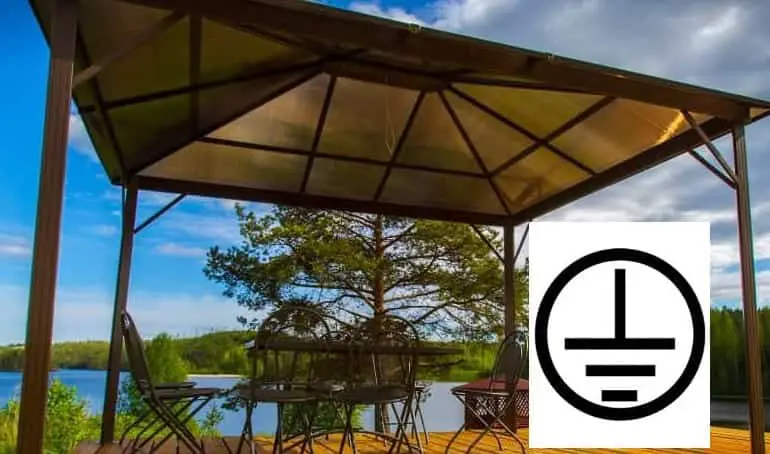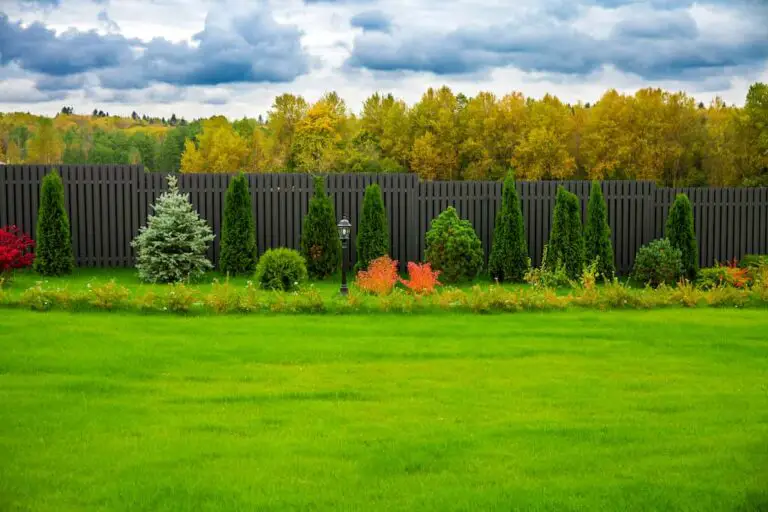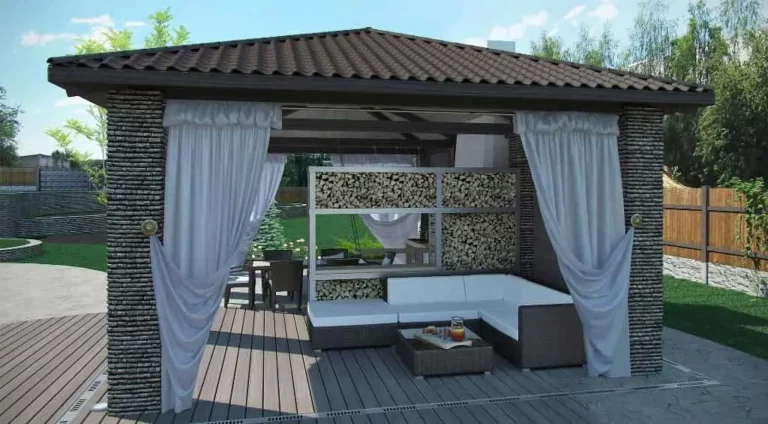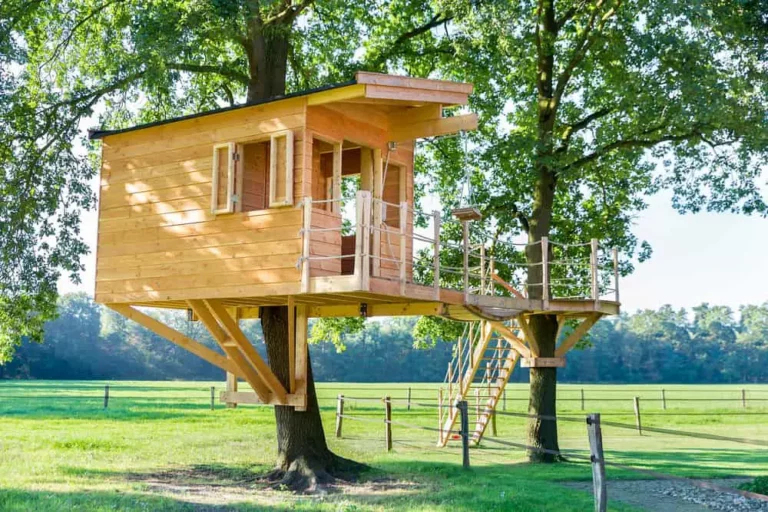Should A Metal Gazebo Be Grounded?

Metal gazebos are a popular outdoor fixture that provides shade as well as a place to sit and rest. However, during thunderstorms, you might feel unsafe under your metal shelter. With lightning as a legit concern, you may be wondering if your gazebo should be grounded?
A metal gazebo should be grounded to protect it and people around it from lightning strikes. Grounding does not make the gazebo completely safe as a shelter during thunderstorms but does make it safer if using it as shelter is necessary.
As with all metal structures, it is best to simply stay away from them during a thunderstorm. However, grounding your gazebo can make it safer. We’ll explain that depending upon the characteristics of your gazebo, grounding it may be easier than you think.
Do Metal Gazebos Attract Lightning?
Metal gazebos do not attract lightning, but they do conduct it.
It is a common misconception that metal attracts lightning. It does however, act as a path for the lightning to follow.
Therefore, if you are standing near a metal gazebo that has been struck by lightning, it will likely pass through the structure to you. Grounding the gazebo offers a more direct path for the lightning to take to the soil rather than through you.
How To Ground Your Metal Gazebo
The easiest way to go about grounding your metal gazebo is with copper rods. You should always offer the lighting at least two different paths, so we suggest using one rod for each leg of the gazebo.
The copper rods need to go at least 6 inches into the ground. Therefore, they need to be longer than the 6 inches. You can purchase four-foot copper grounding rods to ensure your rod is deep and secure enough within the soil.
If your gazebo is sitting on a wooden or cement platform, you will need to drill four holes through the platform at the base of each leg for the rods to go through. This can be done using a hole saw but be sure that it is deep and wide enough for the rod to fit all the way to the ground.
Creating the Current Pathway
Once you are sure the rods will go through the platform and at least six inches into the ground, you can begin clamping the rods to the legs using the rod clamps that usually come with grounding rods.
Check to make sure your copper rods came with rod clamps; if not you can easily buy them at any hardware store.
Drill the clamps into the sides of each leg and then place the rod through the clamp before tightening the clamp around the rod. For the grounding to be effective, all parts of the metal must create a continuous path. Therefore, it is important that all components are tightly drilled and clamped together.
Driving the Copper Rods into The Ground
The copper rods need to be driven into the ground at least six inches to be effective. However, the deeper you can get them, the better.
This is because you do not want any wiggle room with your rods. You want to be sure that they are completely surrounded by the soil to ensure that the electricity flows directly to it and not along the surface of the ground.
We recommend driving the copper rod at least one foot into the ground to prevent any loosening. The deeper your rod is in the ground, the less likely it will be able to wiggle itself loose.
If you are worried about your rod becoming loose, you can pour cement around the edges of the rods. This will help keep it in place and ease your concerns.
A Tip on Driving Copper Rods in The Ground
To ensure your rod is in the ground at the desired depth, measure your rod beforehand. Make sure it is the desire length you wish.
If your rod is longer than your desire length, mark on the rod where six inches or your desired length is. This way, if you hit a rock and are unable to get the rod completely into the ground, you will know whether it has reached the correct length to be effective.
If the rod has indeed reached the correct length, then you can consider cutting the excess piece of the rod off so that your beautiful gazebo is not ruined by random rods sticking out of the ground beside it.
Do I Need to Ground A Gazebo That Is Attached to Something Else?
If your metal gazebo is attached to your house, then it is likely grounded by the pathway your house is and does not require any extra grounding.
If it is attached to another standalone structure in your yard, ensure that the two structures are grounded together. If the other structure is not grounded, you will need to go through the grounding process.
What Does Grounding Do?
Grounding your metal gazebo will provide a low resistance path for the electricity to follow to the ground. It intercepts the strike and guides it to the ground before the electricity can harm the structure or people inside.
In the event of a thunderstorm, lightning can strike a person in five different ways.
- Direct strike
- Side flash
- Ground current
- Conduction
- Streamers
When lighting strikes a metal structure like a gazebo, humans are most often harmed by the electricity passing through the metal through the process of conduction. Grounding the metal prevents the electricity from flowing through it to you.
Dangers of Metal Gazebos and Side Flashes
Side flashes occur when lightning strikes a tall object, such as a gazebo, and a portion of the electricity jumps to the person near it. With a proper grounding system in place, the electricity is more likely to go directly to the ground rather than to the person near or in the gazebo.
The Danger of Ground Current Strikes
Ground current strikes happen when lightning strikes an object, and the electricity travels along the ground surface. The current can cover a large amount of area, possibly killing anyone near the gazebo.
This is why it is so important that the copper rods go deep into the ground. The deeper the rods, the less likely the electricity from the lightning strike will travel across the ground surface.
Do Gazebos That Are Not Entirely Made of Metal Need to Be Grounded?
What if your gazebo only has a metal roof? Does it still need to be grounded? It is not necessary to ground a structure with a metal roof, but we do recommend it. Grounding any structure helps keep it and anyone near it safe during the event of a lightning strike.
A lightning protection system (LPS) consists of:
- Air terminals
- Down conductors
- Ground terminals
The components create a continuous path for the electricity from the lightning strike to follow. The metal roof acts as the air terminal only if it is a continuous metal.
Copper wires attached to the roof by bolting or welding create a path from the roof to the copper rods in the ground. Be sure that the pathway is completely continuous to ensure maximum effectiveness.
Grounding A Metal Gazebo Does Not Make It Perfectly Safe
Grounding a metal gazebo does make it much safer than an ungrounded metal structure; however, it does not mean you should take shelter in it in the case of a thunderstorm. Gazebos are small and wide open, making you an easy target for lightning.
Always seek shelter in a more enclosed building during the event of a thunderstorm. However, grounding the gazebo is still important. You will be protecting your gazebo and the nearby ground from dangerous electrical currents.
Learn more!! see our article The Ultimate Guide To Choose And Install A Gazebo for more information





